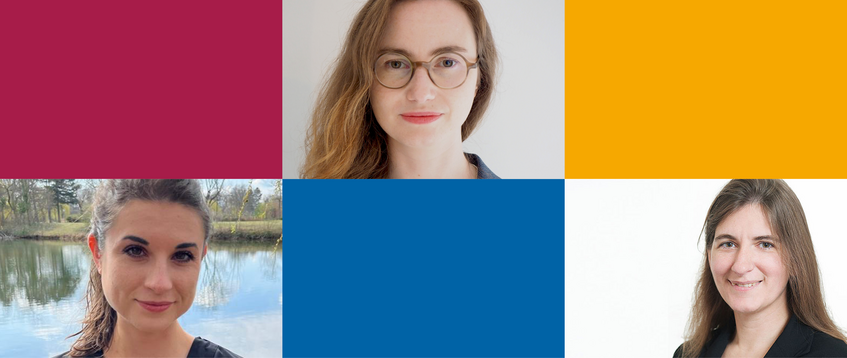Women* in Data Science 2024

In 2016, the United Nations designated 11 February as the International Day of Women and Girls in Science, aiming to foster gender equality within STEM fields. Despite possessing equal capabilities, the global average indicates that only approximately 35% of STEM graduates are women*. Ensuring a diverse representation in science is essential to prevent a narrow perspective and to stimulate the emergence of new ideas, talents, and creativity.
Within our research network, we take pride in supporting and showcasing the pioneering efforts of female* researchers who are pushing the boundaries of their respective fields, making substantial contributions to the scientific community. Join us in commemorating the accomplishments of female* researchers, as we strive to raise awareness and inspire more women* to pursue careers in STEM.
The University of Vienna is uniting to celebrate Women* in Science through a collaborative campaign involving the Faculty of Life Sciences, the Faculty of Earth Sciences, Geography and Astronomy, the Faculty of Computer Science, the Faculty of Physics, the Faculty of Chemistry, the Faculty of Mathematics, the Centre for Microbiology and Environmental Systems Science and our research network Data Science @ Uni Vienna. By uniting various departments, the University of Vienna highlights the significance of diversity in science and emphasizes the pivotal role of women* in advancing the field.
The following is a list of remarkable women* who are active in data science and a brief overview of their accomplishments:


From left to right:
- Sylvia Kritzinger, Professor for Methods in the Social Science at the Department of Government, collects and analyzes survey data to examine public opinion and electoral behavior. Photo © Private
- Judith Staudner, Prae-Doc Researcher in Data Science, focuses on understanding and improving athletic performance through detailed training data and is situated at the intersection of computer science, statistics an sports science. Photo © Franz Pfluegl
- Sofiia Piven, Master Graduate in Business Analytics, is interested in natural language processing and neural networks, investigates how these technologies could be applied to facilitate daily business operations. Photo © Private

From left to right:
- Verena Prantl, Researcher in the Research Group Visualization and Data Analysis, focuses on rhetoric in data visualization. Photo © Marc Kroll
- Laura Koesten, Post-Doc Researcher in the Reserach Group Visualization and Data Analysis, investigates ways to improve the interaction between humans and data. She deals with the understanding of data and its visualization, the search of data and its reuse, as well as ethical and collaborative aspects of working with data. Photo © Sebastian Rahs
- Tara Andrews, Professor for Digital Humanities, explores how we can take advantage of data methods and digital collections to learn new things about medieval history, even when our data and collections have a lot missing. Photo © Ilse Herzinger

From left to right:
- Diana Széliová, Post-Doc Researcher for Systems Biology, uses mathematical models to study cellular resource allocation and evolution. Photo © Theodora Danek
- Christa Cuchiero, Professor for Quantitative Risk Management, is doing research at the intersection of Mathematical Finance, Stochastic Analysis and Foundations of Machine Learning. She is especially interested in classes of universal stochastic processes, approximation theory in dynamic situations, data driven risk inference and machine learning in Finance. Photo © Private
- Doris Vickers, Master student in Digital Humanities, is interested in the transmission of astronomical knowledge from Antiquity to Early Modern times and focuses on the names of constellations and star names in the Middle Ages and the 17th century. Photo © Joseph Krpelan

From left to right:
- Laura Lotteraner, Prae-Doc Researcher in the Research Group Visualization and Data Analysis, focuses on understanding environmental issues concerning ground and surface water and its pollution using data visualization and modern data analysis approaches. Photo © Gabriel Sigmund
- Edina Marica, Master student in Data Science, is interested in Machine Learning and Graph Algorithms. Photo © Private
- Claudia Plant, Professor for Data Mining, focuses on extracting knowledge from massive data. Photo © Barbara Mair

From left to right:
- Tatyana Krivobokova, Professor for Statistical Methods, is a statistician working both on applied and theoretical problems. Photo © Caro Hoene
- Julia Partheymüller, Senior Scientist at the Department of Government, utilizes quantitative and computational methods to explore the public's attitudes, behaviors, and beliefs. Photo © Private
- Julia Strychalska, Master student in Business Analytics, is interested in applying Data Science to real-life scenarios, leveraging the power of data, to make informed decisions on a strategic level. Photo © Private

From left to right:
- Janka Möller, Prae-Doc Researcher at the Department of Statistics and Operations Research and PhD-student in Mathematics, focuses on theory and applications of mathematical finance, in particular the use of machine learning techniques such as signature methods, in the area of portfolio optimization, option pricing and hedging as well as model calibration. Photo © Private
- Rebecca Kahn, Postdoctoral Researcher in Digital Humanities, investigates how knowledge is transformed and transmitted when large-scale collections of digitised museum data are published and shared online. Photo © Ralf Rebmann
